Sewing
box Index

History of sewing
boxes
Request current
list of available sewing boxes
| |
Antique Anglo Indian fully fitted sewing box inlaid with sadeli mosaic circa 1845
Please click on images to enlarge | slide show | thumbnail index |
Reference: Sb403
Description:
SB403: Anglo Indian fully fitted sewing box of pyramided
shape veneered with ivory profusely inlaid with sadeli
mosaic, the box standing on turned ivory feet. Inside
the box is compartmentalized and fitted for sewing, with a liftout tray
of fragrant sandalwood and has supplementary lids and trays each
veneered with ivory inlaid with sadeli, circa 1845.
Origin: India
Circa: 1845
Materials: Sandalwood
ivory ebony rosewood and metal.
Size: 33 cm wide by 23 cm by 13 cm (including
feet): 13 inches wide
by 9 inches by 5 inches (including feet).
Condition: very
good original condition. Small loses and blemishes which have been
consolidated. Please look at large images which are accessed by
clicking on the smaller. Working lock with original key.
|
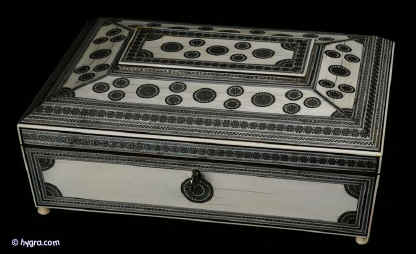
The inlay is rich and complex, and yet remains totally controlled. A
box of this high quality represents hundreds of hours of master
craftsman work.
|

|
Inside the box has a sumptuous
compartmentalized liftout tray of dovetail construction with supplementary
lids each decorated with sadeli
mosaic.
The box retains its original
sewing accessories. There are four thread barrels each with sadeli
inlaid into their tops.
Curiously they have never had
the hole for the drawing of thread drilled. there is also a tape
measure, designed to hold a silk ribbon which would be marked with units
of measurement. However it seems that the tape was never fitted and no
slot for the tape has ever been cut.
There is a framed mirror in
the lid with a velvet covered compartment behind.
|
Please click on images to enlarge | slide show | thumbnail index |
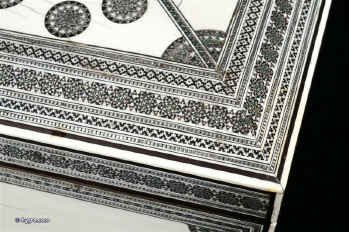
|
The ancient art of sadeli
Mosaic is said to have been introduced from Shiraz in Persia via Sind to
Bombay, a long time before the Anglo Indian boxes were made. It was a
technique, which required a high degree of skill and patience. It was
executed very lavishly, in that the frequent cuts wasted a great amount
of the precious materials used. The workmanship was however more than
commensurable to the value of the materials.
The superb craftsmanship is
evident in the control of the patterns in the complex corner joints with
mitered and specially shaped elements.
Ivory, pewter, rosewood ebony and stained ivory were
cut into faceted rods which were bound together to form geometric
patterns. When the glue had set, the rods were sliced in transverse
sections. This gave the maker a number of angled circular pieces in the
original pattern. Several variations of patterns could be achieved by
combining the materials in different ways. The ivory was sometimes dyed
green as here to give an extra colour.
|
|
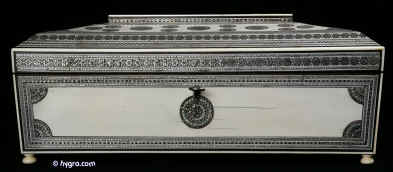
|
Please click on images to enlarge | slide show | thumbnail index |
Ivory, pewter, rosewood ebony and stained ivory were
cut into faceted rods which were bound together to form geometric
patterns. When the glue had set, the rods were sliced in transverse
sections. This gave the maker a number of angled circular pieces in the
original pattern. Several variations of patterns could be achieved by
combining the materials in different ways. The ivory was sometimes dyed
green as here to give an extra colour.
|
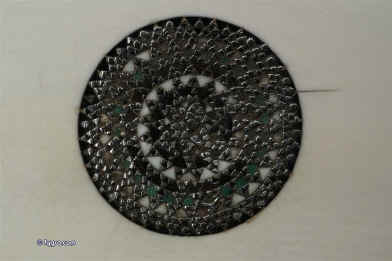
|
Please click on images to enlarge | slide show | thumbnail index |
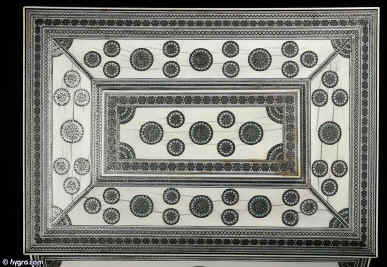
|
The orchestration of the pyramided top with
tapered plains is truly amazing. The design works and is a delight in
both a totality and in the minutia.
|
Please click on images to enlarge | slide show | thumbnail index |
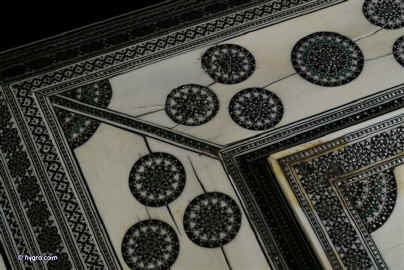
|
The superb craftsmanship is
evident in the control of the patterns in the complex corner joints with
mitered and specially shaped elements.
|
Please click on images to enlarge | slide show | thumbnail index |
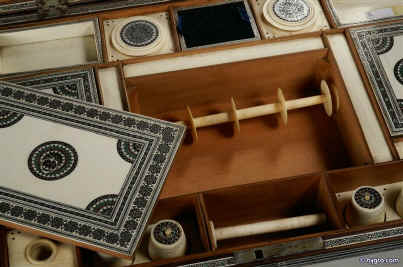
|
Beneath one of the
supplementary lids there is a turned ivory bobbin with divisions
for several coloured threads.
|
Please click on images to enlarge | slide show | thumbnail index |
One of the lids is inscribed with pen:
"For Miss M. F. Potes(?)
with best from
P. M. Potes (?)"
|
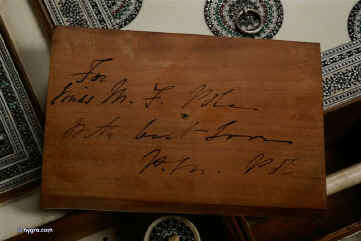
|
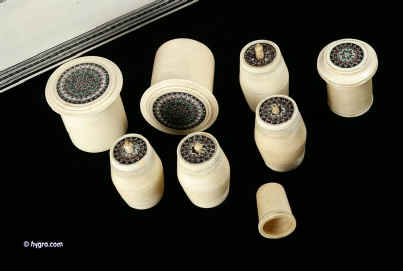
|
The box has a set of four turned ivory thread barrels
and two cylinder shaped boxes and a further turned holder for a silk
tape measure. Each is decorated with a circle of sadeli
mosaic.
Curiously the barrels
have never had the hole for the drawing of thread drilled. there is also
a tape measure, designed to hold a silk ribbon which would be marked
with units of measurement.
However it seems that the
tape was never fitted and no slot for the tape has ever been cut.
|
Please click on images to enlarge | slide show | thumbnail index |
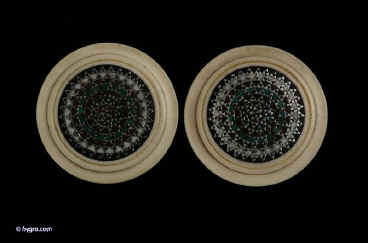
|
Detail of the inlay on the tops of the turned
circular boxes. The inlay combines ivory ebony rosewood and pewter.
The makers (reputed to be
Persian) of Sadeli mosaic displayed a total understanding of the
qualities of the different materials they used. They combined
substances, which can expand and contract according to atmospheric
conditions with others, which are hard and unyielding. The result was
a sharp definition of the lines and patterns, which made up the whole
design.
|
Please click on images to enlarge | slide show | thumbnail index |
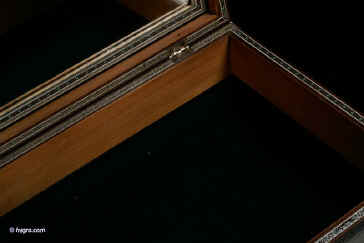
|
Beneath the tray the box is lined with blue
velvet.
|
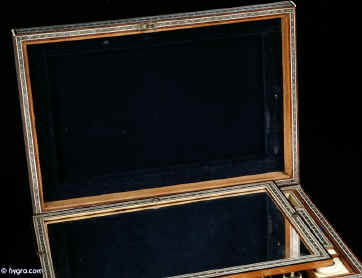
|
There is a further compartment in the lid behind the
mirror which is lined with dark blue velvet.
|
Please click on images to enlarge | slide show | thumbnail index |
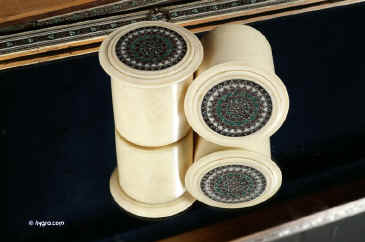
|
A
|
Please click on images to enlarge | slide show | thumbnail index |
View of the bottom. There is a small label which
as yet I have failed to decipher.
|

|
Please click on images to enlarge | slide show | thumbnail index |
Please click on images to enlarge | slide show | thumbnail index |
All text and images and linked images are ©
1999-2008 Antigone Clarke and Joseph O'Kelly. If you require any further
information on permitted use, or a licence to republish any material, email us
at copyright@hygra.com
|
